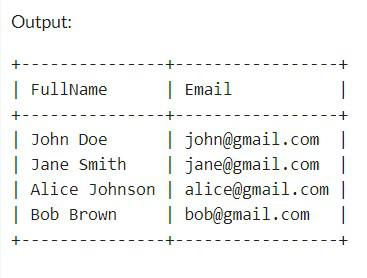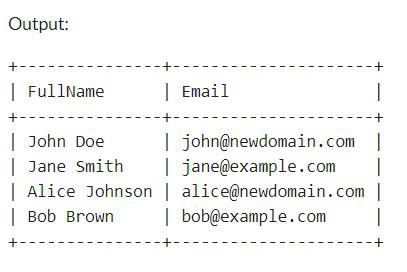In SQLServer, efficient manipulation of strings is crucial for managing databases effectively. Among the fundamental operations are updating and replacing parts of strings within tables. These operations are invaluable for correcting data inconsistencies, enhancing data quality, and transforming textual data to meet specific requirements.
In this article, we will delve deeper into the concepts of updating and replacing substrings in SQL Server, providing comprehensive explanations, syntax, practical examples, and additional insights.
How to UPDATE and REPLACE Part of a String in SQL Server
Updating and replacing substrings in SQL Server involves the use of the UPDATE statement and the REPLACE function, respectively. These tools offer precise control over modifications to string data within database tables. Understanding their syntax, nuances, and best practices is crucial for proficient database management.
UPDATE statement syntax:
UPDATE table_name
SET column_name = REPLACE(column_name, 'old_substring', 'new_substring')
WHERE condition;
REPLACE function syntax:
REPLACE(original_string, 'old_substring', 'new_substring')
These queries enable precise modifications to strings, facilitating data cleansing, standardization, and transformation.
Examples
Let’s create a demo table named Customers in MariaDB and populate it with some sample data to demonstrate the examples provided earlier.
Create a table named Customers and add the fields CustomerID, FullName, Phone, Email, CustomerType using the following CREATE TABLE query:
CREATE TABLE Customers (
CustomerID INT AUTO_INCREMENT PRIMARY KEY,
FullName VARCHAR(100),
Phone VARCHAR(20),
Email VARCHAR(100),
CustomerType VARCHAR(20)
);
Insert the sample data into the customers table, using the following INSERT query:
INSERT INTO Customers (FullName, Phone, Email, CustomerType)
VALUES
('John Doe', '(555) 123-4567', 'john@example.com', 'Corporate'),
('Jane Smith', '(555) 987-6543', 'jane@example.com', 'Individual'),
('Alice Johnson', '(555) 555-1234', 'alice@example.com', 'Corporate'),
('Bob Brown', '(555) 888-9999', 'bob@example.com', 'Individual');
Output:

example table
This script creates a table named Customers with columns for CustomerID, FullName, Phone, Email, and CustomerType. Then, it inserts four sample records into the table.
Now, we can use this Customers table to demonstrate the examples of updating and replacing parts of strings in MariaDB.
Example 1: Updating Part of a String
Consider a scenario where a company needs to update the area codes in phone numbers stored in a Customer table:
UPDATE Customer
SET Phone = REPLACE(Phone, '(555)', '(123)')
WHERE Phone LIKE '%(555)%';
Output:

updated table
Explanation: This query updates the Phone column by replacing occurrences of the area code ‘(555)’ with ‘(123)’ for customers with numbers containing the old area code.
Example 2: Replacing Substring in a String
Suppose a Customers table needs adjustments to Email, replacing ‘example.com’ with ‘gmail.com’:
UPDATE Customers
SET Email = REPLACE(Email, 'example.com', 'gmail.com')
WHERE Email LIKE '%example.com%';
Output:

updated table
Example 3: Updating with Substring Concatenation
In certain cases, updating strings might require concatenation with existing values. For instance, updating email domains for a specific customer segment:
UPDATE Customer
SET Email = CONCAT(LEFT(Email, LOCATE('@', Email)), 'newdomain.com')
WHERE CustomerType = 'Corporate';
Output:

updated table
Explanation: This query updates email domains for corporate customers by concatenating ‘newdomain.com’ with the existing domain extracted using string functions.
String Manipulation Best Practices.
When performing string manipulation operations such as updating and replacing substrings in SQL Server, it’s essential to adhere to certain best practices to ensure efficiency, accuracy, and maintainability. When performing string manipulation operations such as updating and replacing substrings in SQL Server, it’s essential to adhere to certain best practices to ensure efficiency, accuracy, and maintainability:
- Use the WHERE clause judiciously: Use proper WHERE conditions on the rows to specify where the updates should be applied instead of performing all operations even on those unrelated data.
- Test thoroughly: Before updating or replacing environment with production, it is always advised to perform exhaustive testing in staging or development environment to ensure proper implementation and reducing risks.
- Backup data: It is wisest to backup critical data before any large-scale changes are done to avoid the risk of data loss in case things turn out in an unexpected manner.
- Consider performance implications: Take a thoughtful approach to the complications of string manipulation operations, in particular, when the data is say big. Try to have optimized queries to eliminate the tendency of wastage of time in execution.
Conclusion
In conclusion, proficient manipulation of strings in SQL Server is indispensable for maintaining database integrity and optimizing performance. The ability to update and replace substrings empowers administrators to address data inconsistencies, enhance data quality, and tailor textual data to meet specific requirements.
By mastering the syntax and best practices associated with the UPDATE statement and REPLACE function, database professionals can wield these tools effectively, ensuring the seamless management of database resources. Regular practice and exploration of additional string manipulation functions further deepen expertise in SQL Server database management.
Share your thoughts in the comments
Please Login to comment...